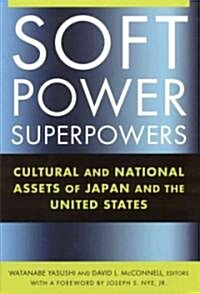
Soft power superpowers: cultural and national assets of Japan and the United States
- 발행사항
- Armonk, N.Y. : M.E. Sharpe, 2008
- 형태사항
- xxxii, 296 p.: ill. ; 24 cm
- ISBN
- 9780765622488
- 청구기호
- 349.42013 W324s
- 서지주기
- Includes bibliographical references and index
소장정보
| 위치 | 등록번호 | 청구기호 / 출력 | 상태 | 반납예정일 |
|---|---|---|---|---|
이용 가능 (1) | ||||
| 1자료실 | 00013191 | 대출가능 | - | |
- 등록번호
- 00013191
- 상태/반납예정일
- 대출가능
- -
- 위치/청구기호(출력)
- 1자료실
책 소개
The term "soft power" describes a country's ability to get what it wants by attracting rather than coercing others. This book analyzes the soft power assets of the United States and Japan, and how they contributed to one of the successful, if unlikely, bilateral relationships of the twentieth century.
목차
Introduction, Yasushi Watanabe and David L. McConnell; Part I: Perception; 1. Anti-Americanism in Japan, Yasushi Watanabe; 2. Japan's Image Problem and the Soft Power Solution: The JET Program as Cultural Diplomacy, David L. McConnell; Part II: Higher Education; 3. Higher Education as a Projection of America's "Soft Power," Philip G. Altbach and Patti McGill Peterson; 4. Facing Crisis: Soft Power and Japanese Education in a Global Context, Akiyoshi Yonezawa; 5. Nurturing Soft Power: The Impact of Japan-U.S. University Exchanges, Ellen Mashiko and Miki Horie; Part III. Popular Culture; 6. The Attractions of the J-Wave for American Youth, Anne Allison; 7. Shared Memories: Japanese Pop Culture in China, Nakano Yoshiko; 8. Japan's Creative Industries: Culture as a Source of Soft Power in the Industrial Sector, Sugiura Tsutomu; 9. Baseball in U.S.-Japanese Relations: A Vehicle of Soft Power in Historical Perspective, Sayuri Guthrie-Shimizu; 10. American Pop Culture as Soft Power: Movies and Broadcasting, Matthew Fraser; Part IV: Public Diplomacy; 11. Wielding Soft Power: The Key Stages of "Transmission" and "Reception," Seiichi Kondo; 12. Official Soft Power in Practice: U.S. Public Diplomacy in Japan, William G. Crowell; 13. Japan Does Soft Power: Strategy and Effectiveness of Its Public Diplomacy in the United States, Naoyuki Agawa; Part V: Civil Society; 14. Mr. Madison in the Twenty-First Century: Global Diffusion of the People's "Right to Know," Lawrence Repeta; 15.Soft Power of NGOs: Growing Influence Beyond National Boundaries, Katsuji Imata and Kaori Kuroda; Notes - Bibliography - About the Authors.

